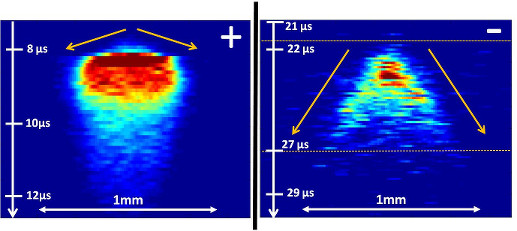
Dr. Olivier GUAITELLA
olivier.guaitella@polytechnique.edu
A number of techniques have been developed to determine gas temperatures in electrical discharges. However they either reposes on questionable assumptions made on the equilibrium between rotational and translational temperature (emission spectroscopy, LIF on rotational level of ground stateâ¦), or they are based on Doppler broadening of the absorption signal of a probe atoms (usually Argon) which implies necessarily a spatial averaging along the line of sight. We have therefore constructed a narrow-line-width pulsed ultraviolet laser to allow measurement of atomic Doppler profiles by TALIF, and demonstrate its application to oxygen atoms in a simple DC discharge in pure oxygen. This news technique opens the door to spatially and time resolved measurements of gas temperature in non thermal plasmas providing a chance to improve one of the major source of discrepancies of all kinetic models.
View online at: http://iopscience.iop.org/article/10.1088/1748-0221/10/11/C11003/meta

The 17th Laiser Aided Plasma Diagnostic Symposium is taking place in Sapporo, in Hokkaido (Japan) from Sunday, 27 September 2015 to Thursday, 1 October 2015. This conference gather researcher from fusion plasma, spectroscopy and low-temperature plasma to exchange on new diagnostics techniques. I will be giving a talk entitled âAbsorption spectroscopy in CO2 and air plasma with QCL: from gas traces to vibrational excitation measurementsâ illustrating how the development of Quantum Cascade Laser gives makes them a powerful non intrusive tool for plasma diagnostic. Beside the molecule density measurement, example of gas temperature determination, vibrational kinetic monitoring will be shown. The advantage of QCL high power emission for the development of cavity techniques will also be shown through the example of Optical Feedback Cavity Enhanced Absorption Spectroscopy that we have used for measurements of formaldehyde with 10 ppt sensitivity.
View online at: http://lapd17.qe.eng.hokudai.ac.jp/00.html

Atmospheric pressure plasma jets have been extensively studied for the last years especially because of their potential applications for surface treatments and biomedical applications. Their interaction with a dielectric substrate is therefore the core of any further developments of these technologies. The work we have just published in collaboration with Dr. Ana Sobota from Eindhoven University of Technology, characterizes the morphology of the spreading of a plasma jet when reaching a target surface for all possible controlling parameters of the jet source. Further details can be found by downloading the paper here.
View online at: http://iopscience.iop.org/0022-3727/48/25/255202
